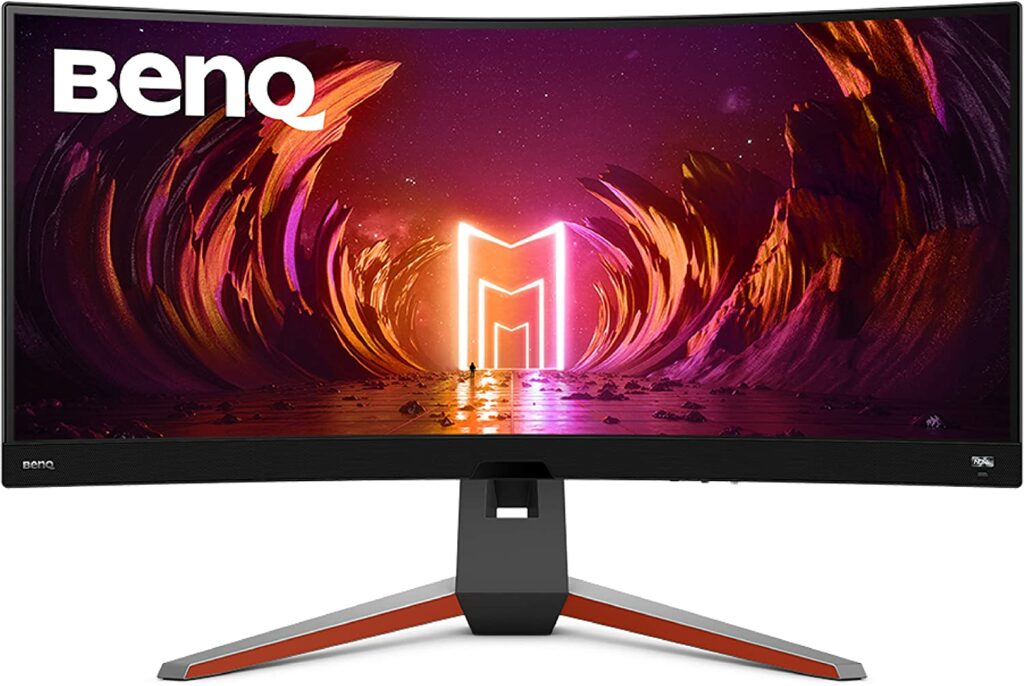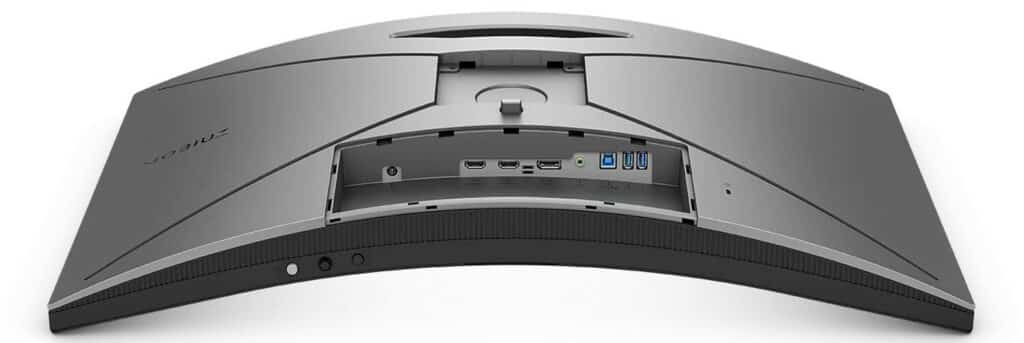The BenQ Mobiuz EX3410R is the VA-based alternative to the premium, IPS-equipped EX3415R for gamers who want to spend less and enjoy more contrast. Cheaper ultrawides are now more common, but BenQ added its premium touch to some features. The BenQ Mobiuz EX3410R isn’t the most affordable since sub-$500 options like the Gigabyte G34WQC exist, but let’s see what it can do to know if it is worth it.
BenQ EX3410R Specifications
- Screen Size: 34 Inches
- Resolution: 3440 x 1440 UW-QHD
- Aspect Ratio: 21:9
- Panel Technology: Vertical Alignment (VA)
- Refresh Rate: 144Hz
- Response Time: 1ms MPRT
- Contrast Ratio: 1000:1 (Static)
- Brightness: 400 cd/m²
- Built-in Speakers: Yes (2 x 2 Watts + 5 Watt Woofer)
- Stand: Height – Yes
- Stand: Tilt – Yes
- Stand: Swivel – Yes
- Stand: Pivot – No
- VESA Compatibility: Yes (100 x 100)
- Connectivity: DisplayPort 1.4 x 1, HDMI 2.0 x 2, USB 3.0 x 3, 3.5mm Audio Jack x 1
- Dimensions (W x H x D): 31.3” x 20.9” x 10.6”
- Weight: 21.7 lbs
Design and Features
The BenQ EX3410R sports the same aesthetic as its siblings in the Mobiuz lineup, so it looks more like a gaming variant. The monitor has a matte black chassis with a silver shell at the back and some red accents on the feet of the base. The display has a three-sided bezel-free design, but it still has inner borders which only become noticeable when it’s in use.
The BenQ EX3410R isn’t compact even by today’s standards, so you have to check your free space for it before buying. It needs over 10 inches of depth thanks to its large base so you might have to rearrange your setup if your desk isn’t deep. It is not that heavy at 21.7 pounds, but it is still easy to get outbalanced while carrying it due to the size.
Build quality for the BenQ EX3410R is great just like with all the other gaming displays from the brand’s Mobiuz lineup. It uses a lot of plastics, but it’s durable enough to not crack or flex when moderate force is applied. The included stand is firm and stable so the large display won’t suddenly sag or shake while you are gaming.
The BenQ EX3410R has an OSD joystick, but it also includes a dedicated remote for its features and settings. It’s nice to have, but it’s a little unnecessary considering that the monitor won’t see couch gaming use due to its format. We also know that it’s an additional that affected the price of the monitor, but we think that it’s a convenient tool rather than a gimmick.
It is also worth noting that the BenQ EX3410R now has LED strips at the back to complete its gamer-centric nature. It’s not RGB since you can only choose between 9 colors and themes, so you can’t sync it with your setup’s other lighting features. It’s bright enough to cast a bias glow at night, but some will prefer to turn it off to lessen distractions.
The stand included with the BenQ EX3410R offers tilt, swivel, and height adjustments so it should be easy to get comfortable with it. Pivoting wasn’t included, but that’s understandable since ultrawides were never meant to be used in portrait mode. You can use VESA mounts, but it will only be necessary if space is limited or if you have other monitors on the desk as well.
The BenQ EX3410R’s connectivity layout is pretty standard since it doesn’t have advanced connectors like HDMI 2.1 or USB-C. It has DisplayPort 1.4 and HDMI 2.0, plus three USB 3.0 ports and a 3.5mm jack for peripherals. It’s comparable to what others like the HP X34 have, but you have to remember that this option has a slightly higher price tag.
It also has the treVolo speakers that are quite better than most built-ins you will find on gaming displays. It has a 2-watt pair with a dedicated 5-watt woofer so it sounds more detailed for entertainment purposes. However, headsets or desktop speakers will still be better since they have more range and are specifically tuned for these purposes.
Display and Performance
The BenQ EX3410R sports a 34-inch 1000r curved VA panel with a 3440 x 1440 resolution, a 144Hz refresh rate, and a 1ms boosted response time. The backlight has a 400 cd/m2 maximum while the contrast is listed at 3000:1 like most VA monitors. It is certified for HDR 400, but we all know how limited that is since it surely doesn’t have a full FALD backlight.
34-inch ultrawide monitors are very popular now since they are great for gaming and productivity. The extra peripheral viewing space is great for immersive FOVs in games and it also gives you more room to maneuver with apps. You can finish your work quicker and be more efficient, although keep in mind that you will need a decent GPU to run this monitor at its maximum.
The BenQ EX3410R renders 99% sRGB and 85% DCI-P3, missing the brand’s claims of an extensive P3 output. It’s not pre-calibrated, so its deltaE average at default is quite high at 3.63 which will result in unbalanced tones and over or undersaturation in some hues. It is not a big issue for games and movies since you will be hard-pressed to know the difference, but trained professionals will know.
Calibrating the monitor reduced its deltaE average to a more balanced 1.67 which makes it usable for some editing and content creation. The bad news is that you have to use a colorimeter to get this result, and those aren’t cheap. You can use the monitor’s sRGB mode instead which posted a 2.11 dE average, although you will lose some settings and a bit of gamut volume with it.
The BenQ EX3410R’s backlight reached 396 cd/m2 at 100%, but it peaked at 500 cd/m2 when it’s HDR mode kicked in. Its contrast reached 3498:1 at 60% brightness, but the monitor isn’t capable of expanding it since it doesn’t have a specialized backlight. Its HDR capabilities are a hit or miss, so you’ll find yourself turning it on and off depending on the media and its compatibility with it.
Panel uniformity for the BenQ EX3410R sample had some issues at the top and bottom edges of the screen. there are some clouding issues near the corners, but they only show up during dark scenes or with an all-black background. This is common with curved displays, but it can vary so there are better units out there.
Its pixel response time is decent despite having the limitations of its panel technology. The monitor also has an overdrive tool that barely adds overshoot at maximum settings, so feel free to use it depending on your needs. The EX3415R is slightly better in this regard, but you’d be hard-pressed to know the difference unless you have them side by side.
The BenQ EX3410R is compatible with both FreeSync and G-Sync so you can enjoy games without tearing and stuttering. Adaptive Sync is crucial with ultrawides since they are more demanding and prone to FPS drops. Input lag sits at 6ms at 144Hz, so there is no need to worry about delays while gaming.
Thoughts on the BenQ EX3410R
The BenQ EX3410R is a great choice if you want an affordable ultrawide that doesn’t leave out some premium qualities. It’s well-designed just like its premium alter-ego even if it’s sold at a slightly lower MSRP. Is VA panel offers great contrast and decent vibrancy, plus it’s responsive enough for fast-paced games.
However, the first flaw on the BenQ EX3410R is again, its price which sits higher than the HP X34 and the Gigabyte G34WQC we mentioned. It is also incapable of great HDR performance, but that’s because it’s not equipped for it. It’s a good choice if you want something that doesn’t cost nearly a thousand dollars just because of additional gadgets and aesthetics.
Pros:
- Good Gamut Coverage and Calibrated Accuracy
- Attractive Design
- Reasonable Price
- Excellent Brightness and Contrast
Cons:
- Poor HDR Performance
- Higher MSRP Than Closest Competitors
- Poor Default Accuracy
About the Author: 





Leave a Reply